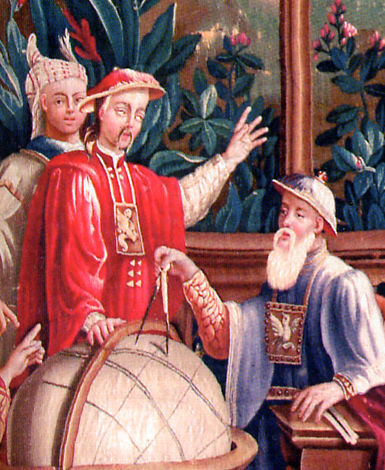How the Jesuits saved the Chinese empire
The contributions made by European Jesuits to the Chinese state in the era of Emperor Kangxi

Detail of a painting made between the late 17th and early 18th century depicting the Chinese emperor Kangxi in dialogue with a European Jesuit. Throughout the 17th century, the Jesuits, given their astronomical and cartographic knowledge, worked as astronomers at the imperial court. Globes, brought by missionaries, were one of the most appreciated European objects in China. - Commons Wikimedia
If the Qing Empire of China did not collapse in the late 1600s, part of the credit must undoubtedly be given to the European Jesuits present in the country. During this period, three key events occurred that earned Emperor Kangxi eternal gratitude toward the missionaries.
The first event dates back to 1673. Some Han generals, who had previously collaborated with the Manchus to establish the Qing Dynasty, rebelled out of fear of losing their privileges and autonomy. During the Revolt of the Three Feudatories, these generals seized control of several regions in the southwestern part of the country. To counter the threat, Emperor Kangxi turned to the Jesuits, aware of their advanced European technological knowledge. The Flemish Jesuit Ferdinand Verbiest oversaw the construction of a foundry capable of producing hundreds of lightweight cannons, which proved decisive in quelling the rebellion.
The second event occurred in 1689. The Russian expansion into the Far East began to threaten the northern borders of the Chinese Empire, corresponding to the ancient lands of the Manchus. Once again, Kangxi relied on the skills of the Jesuits. He sent the Portuguese Jesuit Thomas Pereira and the French Jesuit Jean-François Gerbillon along with his army to negotiate with the Russians at their camp along the river. The Jesuits' diplomatic and linguistic mediation (conducted in Latin) was crucial in drafting the treaty that would regulate the Russo-Chinese border for nearly two centuries.
Finally, in 1692, the emperor began suffering from severe fevers that endangered his life. Once again, it was the Jesuits—specifically Gerbillon and his French compatriot Joachim Bouvet—who used their medical knowledge to cure Kangxi, discrediting the imperial court physicians, who were subsequently exiled for their incompetence.
The Jesuits' contributions were officially recognized by the Chinese government. When Verbiest passed away, he was honored with a state funeral, and the French Jesuits who had healed the emperor were rewarded with the right to reside in a house within the Forbidden City.
Michela Fontana, Matteo Ricci: un gesuita alla corte dei Ming , Mondadori, 2017
Ronnie Po-chia Hsia, A Companion to Early Modern Catholic Global Missions, Brill Academic Pub, 2018
2025-06-16
Salvatore Ciccarello
